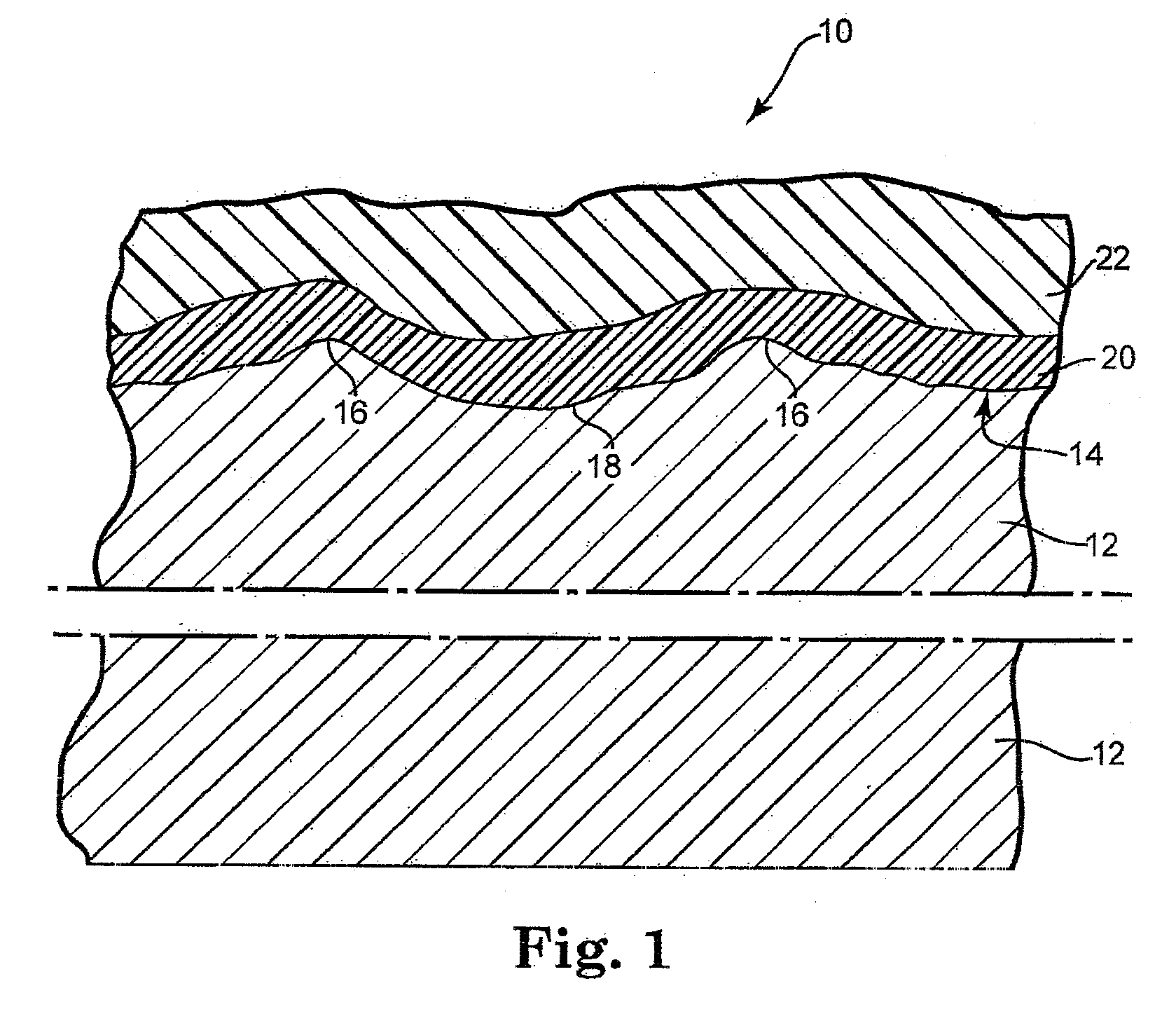Coating System for Cement Composite Articles
a coating system and cement fiber board technology, applied in the direction of coatings, synthetic resin layered products, transportation and packaging, etc., can solve the problems of physical and chemical changes in the composition of cement fiber boards, the damage of repeated freezing and thawing and the significant problem of water absorbed into cement fiber boards
- Summary
- Abstract
- Description
- Claims
- Application Information
AI Technical Summary
Benefits of technology
Problems solved by technology
Method used
Image
Examples
example 1
, Runs 1-3
[0095] Run 1: A two-part “epoxy-amine” composition was prepared by mixing the following ingredients: Part ‘A’ contains 72 parts water and 28 parts EPI-REZ™ 3515 W60 epoxy resin; and Part ‘B’ contains 38 parts water and 21 parts ANQUAMINE™ 281 poly-amine.
[0096] Run 2: A two-part “epoxy-amine” composition was prepared by mixing the following ingredients: Part ‘A’ contains 71 parts water, 19 parts EPI-REZ 3515 W60 epoxy resin, and 10 parts EF 811 (Air Products latex); and Part ‘B’ contains 27 parts water and 14 parts Anquamine 287 poly-amine.
[0097] Run 3: A two-part “epoxy-amine” composition was prepared by mixing the following ingredients: Part ‘A’ contains 64 parts water, 14 parts EPI-REZ 3515 W60 epoxy resin, 10 parts EF 811 (Air Products latex), and 12 parts potassium silicate (KASIL 1); and Part ‘B’ contains 19 parts water and 10 parts ANQUAMINE 281 poly-amine.
[0098] Equal parts by weight of ‘A’ and ‘B’ are mixed and allowed to sit for a 10-minute induction period bef...
example 2
Acetoacetyl Functional Latex Polymer
[0099] A reactor was charged with 567 parts of deionized water, and 1.5 parts RHODAPON™ UB. The reaction mixture was heated to 75° C. under a nitrogen blanket. During heating, a pre-emulsion was formed containing: 331 parts of deionized water, 56.8 parts of RHODAPON UB, 0.9 parts ammonium persulfate, 149 parts of 2-ethyl hexyl acrylate, 732 parts of butyl methacrylate, 28.1 parts of AAEM, and 28.1 parts of methacrylic acid. Once the reaction mixture reaches 75° C., 2.8 parts of ammonium persulfate were added to the reactor and the monomer feed started for a 3 hour feed rate. The reaction temperature was held between 80° C. to 85° C., during polymerization. Once the pre-emulsion feed was complete, the container was rinsed with 20 parts of deionized water and the reaction was held 30 minutes. A post reaction consisting of 0.9 parts t-butyl hydroperoxide mix with 20 parts of deionized water and 0.7 parts of isoascorbic acid mixed with 20 parts of de...
example 3
Multistage Acetoacetyl Functional Latex Polymer
[0100] A reactor was charged with 547 parts of deionized water, and 1.5 parts RHODAPON UB. The reaction mixture was heated to 75° C. under a nitrogen blanket. During heating, pre-emulsion 1 was formed containing: 215 parts of deionized water, 37 parts of RHODAPON UB, 0.6 parts ammonium persulfate, 103 parts of 2-ethyl hexyl acrylate, 470 parts of butyl methacrylate, 18 parts of AAEM, and 18 parts of methacrylic acid. Pre-emulsion 2 was formed containing: 116 parts of deionized water, 20 parts of RHODAPON UB, 0.3 parts ammonium persulfate, 223 parts of methyl methacrylate, 85 parts of butyl methacrylate, 10 parts of AAEM, and 10 parts of methacrylic acid. Once the reaction mixture reaches 75° C., 2.8 parts of ammonium persulfate was added to the reactor and the pre-emulsion 1 started for a 2 hour feed rate. Once pre-emulsion 1 was added, the container was rinsed with 20 parts deionized water and pre-emulsion 2 stated for a 1 hour feed r...
PUM
| Property | Measurement | Unit |
|---|---|---|
| Percent by mass | aaaaa | aaaaa |
| Fraction | aaaaa | aaaaa |
| Fraction | aaaaa | aaaaa |
Abstract
Description
Claims
Application Information
 Login to View More
Login to View More - R&D
- Intellectual Property
- Life Sciences
- Materials
- Tech Scout
- Unparalleled Data Quality
- Higher Quality Content
- 60% Fewer Hallucinations
Browse by: Latest US Patents, China's latest patents, Technical Efficacy Thesaurus, Application Domain, Technology Topic, Popular Technical Reports.
© 2025 PatSnap. All rights reserved.Legal|Privacy policy|Modern Slavery Act Transparency Statement|Sitemap|About US| Contact US: help@patsnap.com

